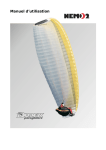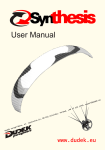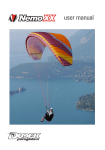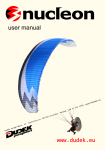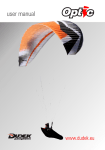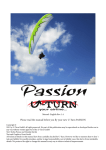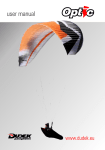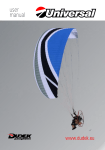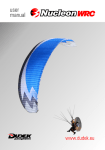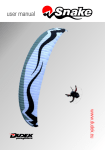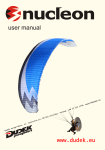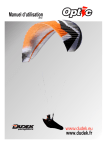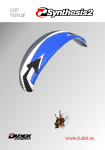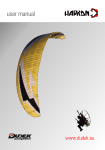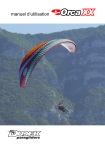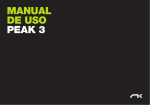Download Manual, english
Transcript
TABLE OF CONTENTS Page 1. Introduction .......................................................................................3 2. The wing................................................................................................4 For whom the FreeWay THE PROJECT DESIGN CLOTH RIGGING RISERS SPEED SYSTEM WHICH HARNESS 3. Flight.....................................................................................................8 PRE-FLIGHT CHECK LAUNCH TURNS THERMALLING AND SOARING FLYING WITH SPEED SYSTEM ENGAGED LANDING WINCHING AND MOTOPARAGLIDING RAPID DESCENDS AEROBATICS WINGOVER EXTREME FLYING MANOEUVRES 4. Canopy care........................................................................................16 STORAGE CLEANING REPAIRS INSPECTIONS DETERIORATION: A FEW TIPS! 5. Technical data.....................................................................................18 6. Warranty, AeroCasco..........................................................................19 7. What have you bought........................................................................21 8. Rigging scheme...................................................................................22 9. Risers: design and accessories .........................................................25 NOTE! Please read this manual before your first flight Important: Trimmer Tape Lock Leaving the factory, paraglider risers are equipped with a plastic buckle blocking trimmer use. As such, the paraglider conforms to the EN norm. However, if you want to get that additional angle of attack regulation, all you have to do is move the buckle toward black loop which pulls the trimmer in. Remember still, the paraglider was NOT certified in any other configuration than fully closed trims. All details concerning full trimmer range option can be found in the manual. Plastic buckle allows you to restore the certified canopy version in any moment. In order to move the buckle, you have to loosen the tape - see pictures: 1 2 3 4 USER MANUAL 1. INTRODUCTION CONGRATULATIONS! We are pleased to welcome you among constantly growing number of Dudek pilots. The Freeway is a freestyle wing, meaning it’s a paraglider characterised by nice manageability enabling good pilots to try acro manoeuvres, while retaining reasonable performance for thermal and dynamic flight. Main reason for this wing was to give a pilot something to play with and find pure piloting pleasure, so we are sure you will make a lot of safe and enjoyable airtime with it. DISCLAIMER Please read this manual carefully and note following details: + Purpose of this manual is to offer guidelines for pilots using Dudek FREEWAY wing and it is by no means intended to be used as a training handbook for this or any other paraglider in general. + You may only fly a paraglider when qualified to do so or when undergoing training by an accredited school or instructor. + Acro flying is dangerous, requiring an expert pilot for successful performing maneouvres. We advise that you learn acro flying at specialized school in safe environment. + Pilots are responsible for their own safety and their paraglider's airworthiness. + Use of this paraglider is solely at the user's own risk! Manufacturer and distributor do not accept any liabilities. + This paraglider on delivery meets all requirements of the EN-926/1 and 926/2 norms or is certified as airworthy by the manufacturer. Any alterations to the paraglider will render its certification invalid. Note Due to constant perfecting of our designs it is possible that actual paraglider can slightly differ from the one described in manual. 3 2. ABOUT THE WING Who should fly the Freeway? Freeway is a small universal canopy designed for those who like to have good fun in the air, including some aerobatics. It is versatile enough to use a few thermals for a small xc, try some acro, have some fun on the dunes, make a couple of hops from small hill or simply... indulge in groundhandling for a while. THE PROJECT The goal of the Freeway was to focus on its manoeuvrability, thus presenting pilot with perfect feeling and fun, while keeping good performance so that staying in the air will be easy when thermalling or soaring. In order to achieve all that we had to meet several points: + easy and playful character in ground training, + good pitch stability accompanied with dynamic roll behaviour, + 120% of usable steering range (brakes operational below stall point), + good behaviour in basic acro manoeuvres (SAT, helicopter etc). + clean design resulting in good performance data. The Freeway was to be simultaneously fun and safe – that’s why we preferred small size for dynamic behaviour and kept modest aspect ratio, so that it could be certified with really wide weight range (55-100 kg ). DESIGN Entire body of the FREEWAY was designed under our Canopy Shape Guard scheme, combining multiple subsystems and resulting in exceptionally coherent and durable body. For more details on individual subsystems, read on. Every second chamber is divided in two cells, and the ribs are additionally supported by VSS (V-shaped supports). Such design practically guarantees smooth top surface, exact aerofoil reproduction across the entire wingspan, better load distribution and yet more importantly, as few suspension points as possible. All along lower surface there is RSS (Reinforcing Strap System) employed a different (than usual ballooning scheme) way of making the wing more rigid and stable. On the leading edge we applied the FET (FlexiEdge Technology). Elastic rods make the leading edge 4 USER MANUAL stiffer and smoother, bringing improvements in many areas - from easier inflation through stiffening the canopy in flight to generally improved airflow. Last but not least, the leading is cleaner for better performance. The cell openings are located on the undersurface of the canopy, close to its leading edge. Their exact position has been chosen so that point of maximum impact pressure stays within intake area as long as possible. We designed them to keep tension of the leading edge in normal flight and to improve paragliders' behaviour in in case of big collapse. Each wingtip is built of several fully closed cells creating stabilizers. Their task is to keep the wing properly tensioned, true on course and regular in turns. They are also equipped with ACS (Auto Cleaning Slots), openings that clean otherwise locked 'dead-ends' of dirt and sand. FREEWAY is produced in new technology, utilizing capabilities of precise laser cutter. All stages of the production process take place as our Polish plant under close supervision of the designer himself, thus ensuring highest European quality. Due to carefully chosen mix of modern design and best materials available the FREEWAY has already shown great durability. All materials used come from registered batches and each production stage can be verified (by identifying individual worker and quality inspector). CLOTH Each cloth has its own characteristics, so they must be properly matched in order to create a harmoniously behaving paraglider. Inside the wing the Ribs, D-ribs, straps and pockets are made of Dominico Tex DOKDO 30DFM (hard finish) (41g/m2), ensuring good durability and load distribution. The rest of the wing is made of Dominico Tex DOKDO 30DMF (41g/m2) for the neutral colors and Dominico Tex DOKDO N20DMF-HD38 (38g/m2) for the color part. RIGGING All suspension lines have coloured polyester sheath covering a core inside. Due to resist to the G-force lines we made sure they are strong enough by employing brown TECHNORA cores. As a result is we have lines that are both strong and offer high stretch resistance. 5 Rigging system consists of individual lines looped and stitched at each end. The upper level (gallery) lines start at the suspension points of the canopy. These lines connect to middle level ones, and these in turn adjoin by twos and threes to single main suspension line. Main lines are attached to risers with quick links (maillons). An additional 'O-ring' is installed there to keep lines together. All maillons are made of polished stainless steel, ensuring great strength, durability and resistance to corrosion. Wingtip lines connect outer suspension points with maillons in similar stepsas above. The same story goes for steering lines. With consecutive cascades they lead from trailing edge down to main brake lines, which then go through pulleys connected to the C-riser and finish at the brake handles. Those lines do not carry any suspension loads. Some of the steering lines in upper level additionally go through a metal loop at the trailing edge. Due to their presence when the line is pulled, the edge gets shortened, thus improving steering effectiveness. Suspension lines are coloured depending on their strength and diameter as follows: + diameter: 2,3 mm; strength: 420 daN; colour: sea-green + diameter: 1,8 mm; strength: 280 daN; colour: red and orange (big ears feature) + diameter: 1,5 mm; strength: 190 daN; colour: violet + diameter: 1,3 mm; strength: 140 daN; colour: green + diameter: 1,2 mm; strength: 90 daN; colour: blue (colour code can differ slightly) RISERS There are 3-way risers in freeway, equipped with: + trimmers of red band designed for have a choice of speed position. + speed system affecting A and B risers Risers are coloured for easy distinction: A - yellow - launch, B - red - B-stall C - grey - deflating the canopy in strong winds (aborting launch) Main suspension lines of A row connect to A riser (yellow ribbon). B row and stabilizer lines go to B riser (red), and C risers (grey, with pulleys added) gather C and steering lines. Brake handles are attached to steering lines at optimal point, guaranteeing best safety and performance. 6 USER MANUAL FREEWAY features our recent brake toggles, distinguished (beside its more robust yet lighter design) by application of two systems: + STC (Sport Comfort Toggle) with swivel, + EK (Easy Keeper) SPEED SYSTEM The heart of speed system is a line sewn into A riser, running through two pulleys and finished with a loop with small hook. There you attach the speed bar line. In normal flight all risers have an overall length of 580 mm. Speed system affects risers A and B. When the bar is being pushed, A and B risers gradually shorten, until there is a 20 mm difference between them. Their minimal length is respectively 480 and 500 mm. C-riser retains its original dimensions. NOTE: An improperly adjusted speed system leads to loss of certification! Speed system adjustment and usage Most of modern harnesses are equipped with special speed system pulleys and sometimes even its own integrated speedbar. If it's not the case, first you need to have some pulleys attached (at best sewn into harness) in such a way that will allow the pilot maximize the output of his/her legs with correct power vector, without effect of pushing the harness back. The speed system cord must be firmly attached (with bowline or other non-slipping knot) to the speed bar. The other end of the cord must be ran upward through the harness pulleys, to be finished with hooks or small carabiners. Overall length of speed system cord should allow pilot to put his/her feet easily into the bar when in flight, and yet should be short enough to cover the full speed range. Make sure that both cords on the speed bar are equal, as even slight difference can result in constant turning of the paraglider. Test your speed system thoroughly on the ground before flying with it! The maximum action is reached when speed system pulleys touch. Before take-off attach paraglider risers to the harness with main carabiners. Then connect speed system cords with hooks or quick-links. Finally make sure that speed system is not tangled and runs freely. To use the speed system simply place your feet on the speed bar and push forward in a horizontal plane. If you notice loss of pressure on the bar, it can be a sign of imminent frontal collapse. In this case release the bar immediately. Watch out for such things - quick wits can spare you most collapses and in general you will increase your awareness of the air around you. Slight speed-bar operation can also optimize your flight, i. e. when entering a thermal. 7 Speed system activation diminishes your paraglider's angle of attack, so that its airspeed is increased. Yet simultaneously canopy becomes less stable that's why you should avoid using speedsystem in turbulent conditions, close to the ground or near other airspace users! Do not use speed system in any extreme manoeuvres! If the canopy does collapse, release the speed bar immediately and correct the situation as usual. WHICH HARNESS? You can use any certified harness with hang point between 35 cm and 49 cm from the seat (the safest distance being 40 cm). Width between carabiners should remain between 37 cm and 45 cm. Please note that any modification of seat/hang point distance changes the position of the brakes in relation to the pilot's body. You must remember that in each configuration the effect of your hands' movement will be different. Caution! Too tight cross straps can dramatically affect the handling, so tightening them actually may not contribute to higher safety. Have them tightened just the correct amount. 3. FLIGHT PRE-FLIGHT CHECK A thorough pre-flight check is essential for any aircraft; the Dudek FREEWAY is no exception. Having unpacked and laid out the paraglider, following checks must be made: + Canopy, lines and risers condition. Do not launch if the slightest damage is noticed, + Paraglider should be arranged in such a way that the centre section A lines (gold risers) will strain earlier that the outer ones. This ensures easy and symmetrical launch. + Central cells have to be laid out carefully, with leading edge even and pre-tensioned. + All lines and risers should be separated. Make sure they are not tangled and pay special attention to the A-lines, which should run free from the A (gold) to the canopy. + It is equally important to untangle the brake lines so that they will not catch anything on the ground during launch. They must be firmly attached to brake handles and run freely through pulleys to the trailing edge. 8 USER MANUAL + See that the risers are not twisted. It is very important not to loop any lines around the canopy. The so-called "line-over" may have disastrous consequences during take off. Always put on and fasten your helmet before clipping risers to the harness. Check quick links (maillons) between suspension lines and risers - sometimes they can unscrew. Check carabiners. They must be properly mounted, closed and locked. LAUNCH Forward launch Should be used with little or no wind. Facing the wind place the risers over your shoulders (A riser must lay on top). Clip it into carabiners and lock them. Grip the brake handles and A-risers (marked with golden ribbon), holding them at the stitching, just under the quick-links. Spread out your slightly bent hands, keeping them down and back. All risers but the A should be placed near your elbow joints. Apply some tension to check if the A risers stay on top and the lines are not tangled. Take a step back, bow down a little and run forward. After the initial inflation smoothly move the hands up and over your head until the wing will be directly above you. Check the wing and let the A risers loose. Pump out possible faults and keep an eye on position of the paraglider. Side drift is corrected best by moving yourself always under center of the canopy (launch space permitting). In order to keep wing in the air the suspension lines must stay taut all the time, so in light winds you will have to run forward. With stronger winds you can control the wing while standing still. When leaving the ground apply some brakes, then release it after gaining some distance from the ground. Reverse launch This technique is complex but safer, because you can have effective canopy check before taking off. After good training it s can be used both with and without wind. After clipping risers into carabiners turn back to face the wing, moving one riser group over your head. As a consequence, you will have the risers crossed. Unlock brake handles and grip them outside of the risers without crossing neither arms, nor lines. In this way you have right brake in right hand. Keeping brake handles in hands take corresponding A risers on both sides. Make sure that the wing inflates symmetrical and the lines are not tangled. Building up tension with a few steps back and simultaneously lifting the A risers will inflate the canopy rise (lift the risers up, not towards you). When it arrives over your head, stabilize it with brakes, check again if everything is OK and turn. Remember to turn always in the same direction. The turn itself should be quick 9 and smooth. While turning you have to release the brake handles and grip them again facing forward. Last check of the wing & free space to launch and off you go. CAUTION: When deflating the canopy in strong winds (e. g. aborting a launch), use C risers, not the brakes. Using brakes in strong wind causes more lift, which eventually can lift the pilot up and drag him/her back. TURNS The FREEWAY is a responsive wing; it has easy handling and reacts instantly to any steering input, with progressive forces on the brakes. Adding some weight shift will make the paraglider turn faster and tighter. The combined technique (weight shifting plus brake input) is the most efficient method. Turn radius is determined then by amount of inside brake used and weight shift. Additional application of a little outside brake after initiating the turn with maximum weight shift increases efficiency and the outboard wing's resistance to collapse (in turbulence, the edge of a thermal etc). When it is necessary to turn the Dudek FREEWAY in a confined area at slow speed (e.g. slope soaring), we recommend to steer the decelerated canopy by loosening the brake at the outside of the turn while applying just a little more brake on the inside of the turn. When entering a turbulent area you should brake a bit, just to put up the tension. It will give you better feel of the wing and allow you to react instantly in case of a problem. CAUTION: Too hard or too quick pulling of one brake can cause the wing to enter a spin. THERMALLING AND SOARING When flying FREEWAY minimum sink is attained with slight brake pressure applied (10 cm to 15 cm depending on pilot's weight). In turbulent conditions the canopy should be flown with small amount of brake applied. This improves overall stability by increasing the angle of attack of the canopy. The canopy should neither rock back nor surge forwards, but always remain above pilot's head. In order to achieve it, paraglider should be accelerated by letting off the brakes when entering a thermal (accordingly to its strength) and slowed down on exiting. This is basic active flying that can spare you many potential collapses. When soaring the slope, a minimum height of 50 m above ground is recommended for safety reasons. It is important to comply with the rules of air traffic, especially when many pilots share airspace close to a hill. In such conditions rapid avoidance manoeuvres are often not possible. FLYING WITH SPEED SYSTEM ENGAGED When flying into head wind or through sink it is advisable (for the sake of best 10 USER MANUAL glide angle) to increase speed, as long as conditions are not too turbulent. Remember that by application of speed system overall angle of attack diminishes and the canopy may tuck easier than in normal flight. The faster is your flight, the more dynamic are tucks and stalls. See "Speed system" section. TRIMMERS Freeway is equipped with short trimmers of 35 mm range, affecting B and C risers. The idea is to make possible fine-tuning of the paraglider and adjust it to specific situations. For example, released trimmers can help at: + launching in nil wind or slight tailwind (canopy inflates easier and rises faster) + launching in strong wind (you will clear the launch area faster - but take care, as the wing will rise with more speed and energy) + flying against headwind (more speed) NOTE: paraglider will be certified with closed trims only. Behaviour of the wing and its reactions with opened trimmers will be more dynamic than usual. Always operate the trims symetrically. LANDING The FREEWAY is easy to land. Final leg of the landing approach must bring you into wind. At approximately 1 meter above ground pilot should flare the canopy, applying brakes accordingly to conditions. The glider may even climb again for a while gaining some height, if too much brake is used. Strong wind landings hardly requires braking, if any at all! Use C-risers (coloured grey) to deflate the canopy after landing. Using brakes will probably result in pilot being lifted and dragged backwards. Final glide of the landing approach should be straight and smooth. Steep or alternating turns can result in a dangerous pendulum effect near the ground. WINCHING AND MOTOPARAGLIDING During tests numerous flights were made with winch start and backpack power units. No contradictions were found for using FREEWAY in such flights. CAUTION: During start, especially winched or with a motor, always remember to bring the wing directly over your head. The aerofoil and its angle of attack were arranged so as to give maximum lift coefficient with relatively high safety. As a result it can stay behind a pilot, if he neglects bringing it directly over head during launch. 11 RAPID DESCENTS Big Ears You can deflate both wingtips simultaneously by pulling down the outer A lines by approximately 50 cm. It is important not to let off the brake toggles while entering the Big Ears manoeuvre. When folded, paraglider will maintain straight course with an increased sink rate (up to 5 m/sec). The canopy remains controllable with weight shifting. On releasing the A' risers canopy usually reinflates spontaneously, or can be aided by a long pump until the tips get clear. Due to possibility of entering parachutal stall it is advisable to apply speedbar after folding the wingtips, in order to diminish AoA. CAUTION: See Parachutal Stall section. Spiral dive You can reach highest sink rates by spiralling. Significant G-forces, however, make it difficult to sustain a spiral dive for long, as it places high loads on the pilot and glider which can lead even to a blackout. The Freeway enters a spiral easily and it’s really important to learn a spiral dive under guidance of a qualified instructor, since exiting the spiral is not automatic and requires pilot action. If the paraglider does not recover after releasing the brake, you must support it applying outer brake. Then once the wing exits the spiral dive, you have to disperse excessive &energy in one additional turn before returning to normal flight. NEVER DO BIG EARS IN A SPIRAL! Tests have proven that loads in a dive can be even higher than those used in certification tests (i.e. 8 G). This could result in structural failure of the glider, as smaller number of lines is taking those increased loads. B-Stall To enter a B-stall simultaneously pull down both B-risers (red) by 10-15 cm. The wing will collapse on entire span along B-row, airflow over the top surface will break and canopy surface will be decreased. Forward movement will be almost completely gone. Avoid pulling of the B-risers deeper, as it increases the wing instability. If the canopy forms a horseshoe with wingtips in front of the pilot, gently apply brakes to recover. 12 USER MANUAL To exit B-stall both risers should be released in a smooth and decisive manner. On quick and symmetrical releasing B-lines airflow reinstates and the wing surges forward, returning to normal flight. CAUTION: see Parachutal Stall section. All rapid descent techniques should be practiced in smooth air and with sufficient height only! Full stalls and spins are to be avoided as recovery procedures, since irrespectively of paraglider type they may have dangerous consequences! BY FAR THE BEST TECHNIQUE IS WISE, CORRECT AND SAFE FLYING, SO THAT YOU WILL NEVER HAVE TO DESCEND RAPIDLY! AEROBATICS This Glider has been designed and built as a freestyle/acro wing. However a specific standard of certification for acrobatic wings has not been set up yet, so even as all Dudek canopies are designed to the highest requirements, the Freeway is not officially certified for acro flying. As aerobatic manoeuvres are difficult and incorrectly performed can put abnormal stresses on the glider and lead to loss of pilot control, Dudek recommends that you undertake this style of flying only under guidance of an instructor. The designer, manufacturer, distributor, and retailer cannot and will not guarantee your safety when using this equipment. This wing should only be used by qualified and competent pilots. You alone must take full responsibility to ensure that you understand the correct and safe use of this equipment and to keep all safety procedures before and during use. We strongly recommend expert tuition over water with a life jacket for those new to acro. This equipment requires regular maintenance, over time many factors such as solar radiation, dirt, grease, water, stress and other variables will degrade the materials, performance and safety of the equipment, thereby increasing the risk of injury or death. WING OVER You make a wingover by executing a series of consecutive, alternating turns with constantly growing bank angle. Too much banking with some flaws in coordination can evoke pretty dynamic collapse. EXTREME AND DANGEROUS SITUATIONS CAUTION! PROVOKING EXTREME SITUATIONS SHOULD ONLY BE CARRIED OUT DURING SAFETY TRAINING COURSE (INSTABILITY TRAINING) UNDER PROPER GUIDANCE! WHILE PROVOKING OR EXITING REAL SITUATIONS THERE IS DANGER THAT YOUR ACTIONS WILL PROVE TOO QUICK OR TOO STRONG, SO YOU SHOULD EMPLOY 13 GOOD JUDGMENT, STAY CALM AND TAKE MEASURED ACTIONS. Since all actions required to exit or prevent dangerous situations on FREEWAY are typical and pilots flying this wing should already have some experience, we are going to describe only the characteristic features for this paraglider. Description of standard dealing with extreme situations can be found in textbooks. SIDE COLLAPSE May happen in strong turbulence. Usually FREEWAY does not turn much after collapse, but due to its size its behaviour can be pretty dynamic. Other than that standard rules apply (keeping direction with some brakes or weightshifting and pumping out when necessary). If the collapse occurs in accelerated flight, immediately release the speed bar. Under normal conditions FREEWAY will reinflate spontaneously. FRONTAL COLLAPSE Can happen in strong turbulence. Active piloting will usually prevent its occurrence. Under normal conditions FREEWAY reinflates instantly and spontaneously. Applying some brakes in the right moment will greatly speed up recovery. FULL STALL AND SPIN Practically do not occur spontaneously. It may happen only as a result of serious mistake or intentional action. Just be careful when flying with low speeds, until you feel familiar and comfortable with new wing. Wing recovers spontaneously in initial phase of stall, otherwise use standard procedures. PARACHUTAL STALL Under normal conditions does not occur. If you want to prevent it, stick to a couple of rules: + after B-stall, release the risers quick and evenly. FREEWAY does not jump forward excessively. + after Big Ears execution engage speed system. It will increase the sink rate and safety margin, as big ears constitute an aerodynamic brake with significant loss of speed. Nevertheless, if such a situation happens, apply some pressure to speed bar and/or push the A risers forward. LINE OVER (CRAVATTE) FREEWAY is a rather small canopy with meagre aspect ratio, so cravatte is 14 USER MANUAL not very likely to happen. However during aerobatics (especially after some badly executed manoeuvre) everything is possible. If it happens, you can start by pull on the stabilo line or a couple of stronger pulls with brake or stabiliser line will clear things out. If it does not solve the problem, try big ears or pulling down corresponding riser. In case of any doubts pilot should seriously consider throwing the rescue chute. EMERGENCY STEERING In case of any malfunction rendering steering with brakes impossible, you can safely steer and land using the C-risers (grey ribbon) or stabilo lines. 15 4. PARAGLIDER CARE Looking after your paraglider will prolong the life of your Dudek FREEWAY. FOLDING AND STORAGE OFREEWAY's design incorporates newest technologies, including nylon lines in the leading edge. That's why the paraglider should be carefully packed, with proper conditions ensured for transport and storage. Basic rules to be followed when folding the canopy: 1. Fold it accordion-wise rib to rib (cell by cell). Do not fold it by halves, placing the stabilizers at the centerline. 2. When a compact package is created along the longest chord do not roll it, but fold three to four times, from trailing edge towards the leading one. 3. The leading edge remains on top of folded canopy. Store the paraglider in a dry place, away from chemicals and UV exposure. Never pack or store the glider when wet. Remember that the wing becomes damp also while lying on green grass in direct sunlight. A good precaution to avoid dampness and/or UV when you have to wait in a start queue is to use quick-pack after rigging up. Always dry the glider thoroughly before packing and/or storage. Never pack you paraglider too tightly. While drying, never expose your paraglider to direct sunlight operation. Please note that with frequent kiting/groundhandling exercises your paraglider will deteriorate faster due to its repeated rising, falling and being dragged on the ground. CLEANING Clean the paraglider with water and a soft sponge. Do not use any chemicals or spirits for cleaning, as these can permanently damage the cloth. REPAIRS Repairs should be carried out exclusively by the manufacturer, authorised distributor or authorised workshop. It is acceptable to fix minor cloth damages with self-adhesive patches included in package. INSPECTIONS Full inspection is recommended every year, if not advised otherwise by the inspecting person due to current paraglider condition. 16 USER MANUAL Paragliders in commercial use (training and tandem flights) should be undergoing Full Inspection every 12 months (excluding first 24-month period after purchase). Technical inspection is carried out by the manufacturer or authorised person. DETERIORATION: A FEW TIPS! The Dudek FREEWAY is mainly made of NYLON, a cloth which - like any synthetic material - deteriorates through excessive exposure to UV. Hence it is recommended to reduce UV exposure to a minimum by keeping the paraglider packed when not in use. Even when packed in the bag, it should not remain in the sun for long. The Dudek FREEWAY lines consist of Technora inner core and polyester sheath. Putting them to excessive loads in flight and much folding on the ground should be avoided, as it can cause irreversible damage. Keep the paraglider clean since getting dust in the lines and cloth will reduce their durability. Be careful to keep snow, sand or stones away from entering the cell openings: their weight can slow down or even stall the glider, and sharp edges can damage the cloth! Prevent lines from catching anything on launch as they can get overstretched or torn. Do not step onto lines. Uncontrolled strong wind takeoffs or landings can result in the leading edge of the canopy hitting ground at high speeds, which may heavily damage the ribs and surface cloth. Knots can chafe the suspension and/or brake lines. Check line lengths after tree or water landings, as they can stretch or shrink. A line plan may be obtained from the dealer or our website when needed. After landing in water you should check the wing cloth as well, since the wave forces can cause the fabric to distort in specific areas. When taking the wing out of water, always do that by the trailing edge, so that water can flow out freely. After sea landing rinse the paraglider with fresh water. Since salt crystals can weaken the suspension lines even after rinsing in fresh water, you should replace them with new ones immediately after contact with salty water. 17 5. TECHNICAL DATA FreeWay 19,5 22 - EN D - LTF D 51 53 19,50 22,00 Surface area (projected) [m ] 17,03 19,21 Span (flat) [m ] 10,23 10,95 Span (projected) [m ] 8,58 9,18 Aspect Ratio (flat) 5,37 5,45 Aspect Ratio (projected) 4,32 4,39 Max. cord [cm ] 228,09 240,51 Min. cord [cm ] 61,58 64,93 Distance pilot to w ing [m ] 6,85 7,20 Total line lenght [m ] 308,15 326,03 Weight range [kg] 50-80 55-100 5,4 5,9 Certification Num ber of cells 2 Surface area (flat) [m ] 2 Weight [kg] Lines Technora: 1,2 & 1,3 & 1,5 & 1,8 & 2,3 Fabric Dominico tex 38 g/m2 Dominico tex 41 g/m2 Dominico tex Hard 41 g/m2 SR Scrim, SR Laminate 180 g/m2 Risers 18 PASAMON - Bydgoszcz, Polska USER MANUAL 6. Warranty and AeroCasco Purchase of a new paraglider is a serious expense for any pilot. That is why we cover our paragliders with extensive warranties and additionally offer an AeroCasco insurance against damage and repair costs. WARRANTY Dudek Paragliders guarantees free of charge repairs caused by the material or production faults along following scheme: For the free-flying paragliders warranty covers 36 months (3 years) or 300 flight hours (depending on what comes first).If the paraglider is used for powered flights, every hour spent in the air should be counted as two (does not apply to dedicated PPG canopies). For the PPG paragliders warranty covers 24 months (2 years)/200 flight hours (depending on what comes first). For the freeway, mountaineering (MPG) and speedflying/speedriding wings as well as school and profit users warranty covers 18 months (1.5 year)/150 flight hours (depending on what comes first). WARRANTY DOES NOT COVER: + canopy colour fading + damage caused by chemicals or salt water + damage caused by incorrect use + damage caused by emergency situations + damage resulting from accidents (airborne or not) WARRANTY IS ONLY VALID IF: + flight hours are correctly registered in the logbook of the owner (and possible earlier owners), distinctly marking PPG flights, + the paraglider is handled in accordance with the operating manual, + the purchaser has not carried out any repair by him/herself (excl. minor repairs with self-adhesive patches), + carried out any modifications, + the paraglider can be unmistakably identified + the paraglider was being inspected according to prescribed timetable. If you have ought your paraglider second-hand, ask its previous owner of the paraglider for a logbooks copy (total of flying hours since the date of first purchase). 19 AEROCASCO Normal warranty does not cover repairs of damages caused by the user or a third party. As costs of such repairs can be considerable, Dudek Paragliders offer an AeroCasco insurance. It covers a one-off repair of any mechanical damage, no matter how big and whoever inflicted them.The only expenses the purchaser has to pay are shipping costs and so-called share-of-cost amount. AeroCasco can be purchased only for a brand new paraglider (at the paraglider purchase). Its cost is 50 euro. NOTE: AeroCasco is not available for all paragliders (check this before purchase). It can be obtained for privately used wings only. AeroCasco applies only to damages that took place during take-off, flight or landing. Obviously, all faults in the material and manufacturing flaws are covered by normal warranty. When handing the paraglider for the repair you have to present a card confirming its AeroCasco status. After the repair you will have to cover only the share-of-cost value of 50 euro. AeroCasco is valid for one repair only.There is a possibility to extend AeroCasco for one more year. To do this you have to send your paraglider for inspection not later than a year after the date of purchase. Extension fee is 75 euro (incl. inspection). Remember to attach the AeroCasco confirmation on expedition. AeroCasco does not apply to any of the following: theft, colour fading, damage caused by incorrect storage or transport, damage caused by chemicals, salt water and force majeure. 20 USER MANUAL Summary: If you respect rules of safe flying and proper glider care, you will enjoy many years of pleasant airtime on your paraglider. Still, you must be aware of present dangers and stand up to them wisely. You must accept the fact that all air sports are potentially dangerous and your actual safety depends solely on you. We insist that you fly safely. This concerns both the weather choice and safety margin during all manoeuvres. FLYING THE PARAGLIDER IS ALWAYS YOUR OWN RESPONSIBILITY. SEE YOU IN THE AIR! 7. WHAT DID YOU BUY Dudek paraglider you’ve bought includes: + Backpack + Transport bag (with your canopy inside). + Paraglider itself (canopy, lines, risers). + Compression strap for tightening up the wing before putting it into a bag. + Windsock. + Pocket with paper work and repair wallet including: ? A piece of self-adhesive fabric for small repairs (10 cm x 37,5 cm). Note this excludes even small rips placed in the vicinity of the stitches – they have to be repaired by an authorised workshop. ? Looped and stitched suspension line. It is equal to the longest line used in the paraglider and has to be used as temporary replacement only. Do not cut it if you have to replace a shorter one, just tie it at the length needed. ? A paraglider passport with entered date of purchase ? and valid technical inspection (please check serial number with the sticker on a wing tip). ? The User Manual you are reading. You will receive some small gifts as well. 21 8. RIGGING SCHEME The rigging scheme itself is published on the next page, while tables of line lengths you will find on our website www.dudek.eu Line lengths are measured with specialized, computer-operated device. All lines before cut are stretched with a steady 5 kg load. Thanks to the abovementioned device and proper procedures final tolerance of line lengths does not exceed 0.15%. CAUTION!!! Distances given below are to be understood as distances between connection points. When cutting a line for repairs, 200 mm more must be counted, as on each end a 100 mm stitch is required to fix the loop. The only exception is main steering line (brmain), which is looped at the upper end only, while down there is 200 mm margin left for fastening the brake handle (that means 300 mm more is needed to be cut). Length of the steering line is given for the high hangpoint scenario (i.e. longer lines). For the lower hangpoints line is shorter by some 15 cm (you have to fix the handle higher. 22 USER MANUAL 23 24 USER MANUAL 9. Risers and accesories C B A' steering line pulley covered swivel steering handle Easy Keeper magnets trimmer buckle speed system pulleys speed system hooks carabiner 25 Speed system influence on the aerofoil Risers neutral (without speed) Full speed Slowest speed, minimum sink, Take off position Increased speed, increased sink speed system: A - 480 B - 500 C - 580 All risers neutral at: 580mm C 26 B A C B A USER MANUAL Trimmer influence on the aerofoil Trimmer off Trimmer on and full speed Icreased trim speed, Sink increased a little Increased speed, Increased sink speed system: A - 580 B - 590 C - 615 speed system: A - 480 B - 500 C - 580 C B A C B A 27 Stabilizer Leading edge Rib Intakes Cell Trailing edge Fot. Chooksprod.com V 28.08.2012 MADE IN EUROPE
































